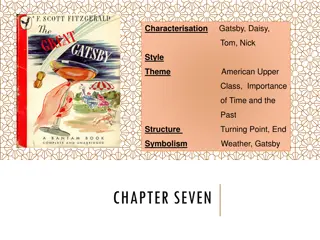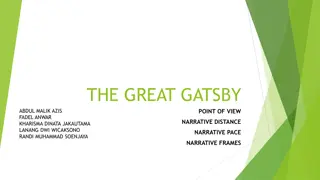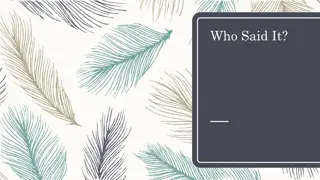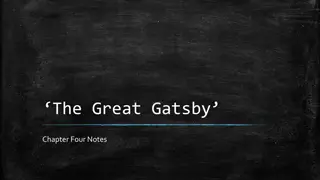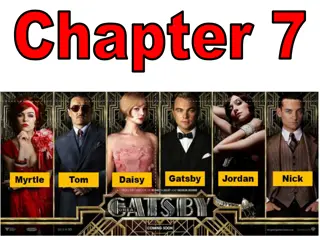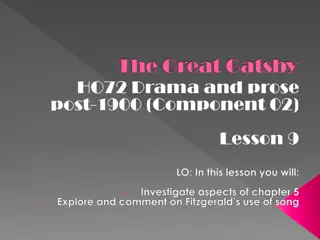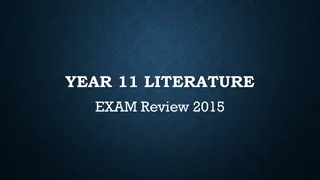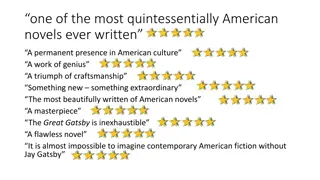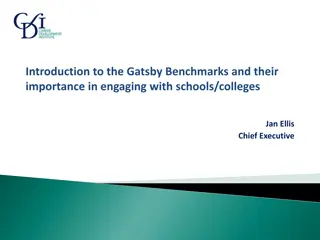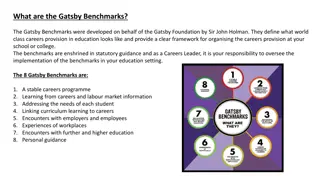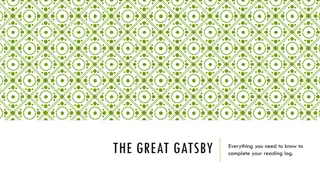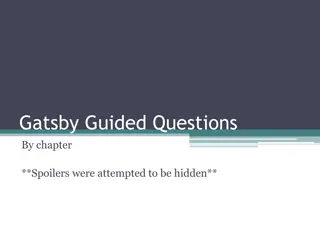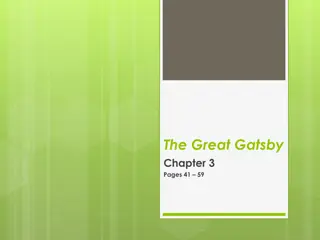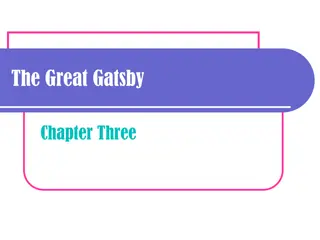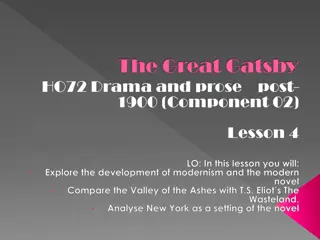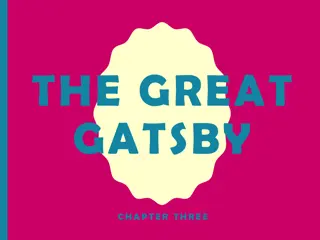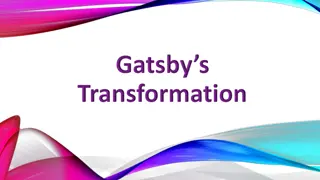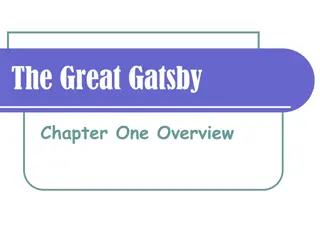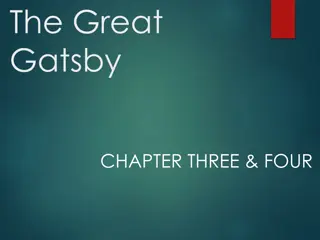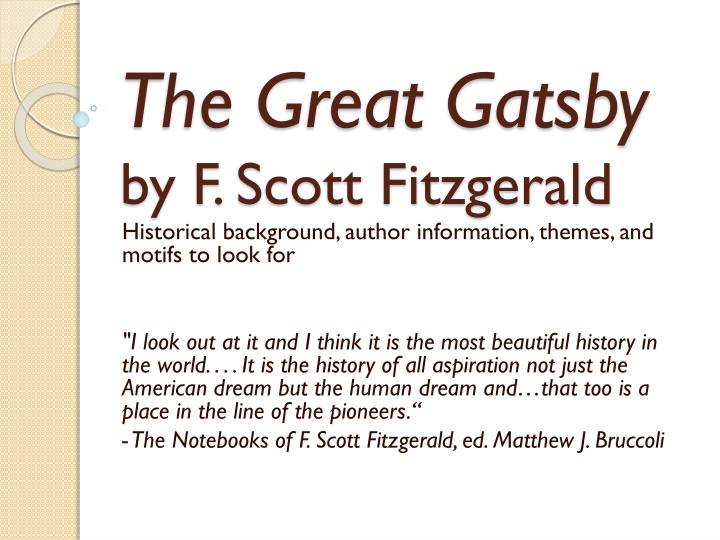
The Great Gatsby by F. Scott Fitzgerald: Historical Background, Author Insights, Themes, and Motifs
Explore the historical context, author information, prevalent themes, and motifs in F. Scott Fitzgerald's "The Great Gatsby." Delve into the Jazz Age of the 1920s, Prohibition era, fashion trends, and the captivating life of the author himself, including his relationship with Zelda and the inspirations behind his iconic novel.
Download Presentation

Please find below an Image/Link to download the presentation.
The content on the website is provided AS IS for your information and personal use only. It may not be sold, licensed, or shared on other websites without obtaining consent from the author. If you encounter any issues during the download, it is possible that the publisher has removed the file from their server.
You are allowed to download the files provided on this website for personal or commercial use, subject to the condition that they are used lawfully. All files are the property of their respective owners.
The content on the website is provided AS IS for your information and personal use only. It may not be sold, licensed, or shared on other websites without obtaining consent from the author.
E N D
Presentation Transcript
The Great Gatsby by F. Scott Fitzgerald Historical background, author information, themes, and motifs to look for "I look out at it and I think it is the most beautiful history in the world. . . . It is the history of all aspiration not just the American dream but the human dream and that too is a place in the line of the pioneers. -The Notebooks of F. Scott Fitzgerald, ed. Matthew J. Bruccoli
The 1920s The Jazz Age Fitzgerald himself coined the term Reaction to the death/destruction/loss of innocence from WWI (post-war prosperity) During this time, there was a mass migration from rural areas to cities where parties were bigger, the pace was faster, the buildings were higher, the morals looser (Fitzgerald) Some called it the first truly modern decade Louis Armstrong and Duke Ellington were popular musicians of the day Dances like the Charleston, the Shimmy, and the Toddle were popular (http://www.youtube.com/watch?v=yN AOHtmy4j0)
PROHIBITION 1920-1933 sale of alcohol was prohibited in the United States; mandated by Constitutional amendment Meant to improve lives of Americans (faith-driven initiative) Instead, liquor consumption grew exponentially Created criminals (lots of $$ to be made) Gatsby? Speakeasies were the places to consume liquor (bars)
F. Scott Fitzgerald Born September 24, 1896 Died December 21, 1940 Only son of an aristocratic father and energetic mother named after Francis Scott Key, a relative of his father s Went to private schools and attended college at Princeton Leading figure in a dramatic society, The Triangle Club Neglected his studies flunked out and joined the army
F. Scott Fitzgerald Met his wife, Zelda, while stationed in Alabama She refused to marry him due to his lack of success 1920 - published his first novel This Side of Paradise it made him famous! Zelda agreed to marry him Called the prince and princess of the generation The couple had a daughter, Scotty, in 1921
F. Scott Fitzgerald The family moved to the French Riviera Wrote Gatsby there Part of a group of ex-pats that included Ernest Hemmingway In 1930, Zelda had the first of several mental breakdowns Sent to sanitarium in Switzerland; she spent the rest of her life in both inpatient and outpatient care The couple returned to America for good in 1931
F. Scott Fitzgerald Although Fitzgerald was a famous author, the couple spent the money much faster than he earned it. 1935-37 is known as the crack up in Fitzgerald life Decent into alcoholism In debt Unable to be a present father for Scotty (sent to boarding schools) Fitzgerald went to Hollywood in 1937 to try his luck at screenwriting He won a substantial contract with MGM, but still wasn t financially viable due to his debt Met and fell in love with Sheilah Graham Fitzgerald died of a heart attack in Graham s apartment in 1940 Zelda died in a fire in 1948
Novels Magazines, Newspaper Short Stories This Side of Paradise (1920) The Beautiful and the Damned (1922) The Great Gatsby (1925) Tender is the Night (1934) The Last Tycoon (unfinished) Featured in Esquire, The Saturday Evening Post All the Sad Young Men (best collection of short stories) Famous Works
The Great Gatsby (1925) Characters Nick Carraway - narrator Jay Gatsby a pun on the slang term gat (pistol) Tom & Daisy Buchanan old $$ Jordan Baker based off Edith Cummings, 1923 women s golf champion; combines two car names the sporty Jordan and conservative Baker Electric George & Myrtle Wilson Tom s mistress and her husband; live in the valley of ashes Meyer Wolfshiem based on Arnold Rothstein, a real-life gangster
The Great Gatsby (1925) Setting The East and West Eggs fictionalized peninsulas on Long Island Sound East Egg representative of old money ; Tom and Daisy live here West Egg the newly rich live here not quite accepted into the folds of the old moneyed; Gatsby s mansion is here
The Great Gatsby (1925) Setting Gatsby s mansion: set on 40 acres; colossal, flashy, garish Symbolic of Gatsby s success and the American Dream Also symbolic of the hollowness of money, success Serves as Gatsby s lure for Daisy
The Great Gatsby (1925) Setting Valley of Ashes - where George and Myrtle live Considered to be Flushing, in Queens, NYC Dead, gray, powdery People passed through the area in cars and on trains on their way to and from Manhattan
The Great Gatsby (1925) Setting New York City and Plaza Hotel symbolizes excess of the times Where much of the irresponsibility (adultery) and excess (drunkenness) of the novel take place
The Great Gatsby (1925) Motifs Money Hypocrisy Friendship Carelessness Dishonesty The American Dream Cars/Driving Ashes/Dust Time/Clocks Colors: green, white, yellow, silver, gold
The Great Gatsby (1925) Symbols The green light at the end of Buchanan s dock Gatsby s library/books Dr. T.J. Eckleburg s eyes on the billboard Owl Eyes Valley of Ashes East Egg/West Egg
SOURCES http://www.pbs.org/kenburns/prohibition/about/ http://www.swisseduc.ch/english/readinglist/fitzgerald_fscott/geo.html http://www.pbs.org/wgbh/amex/monkeytrial/peopleevents/e_jazzage.html http://reading.cornell.edu/reading_project_06/gatsby/great_gatsby_resou rces.htm http://www.biography.com/people/f-scott-fitzgerald-9296261 http://image1.findagrave.com/photos250/photos/2009/345/344_12606452 0224.jpg http://i.telegraph.co.uk/multimedia/archive/01813/FScott_1813988b.jpg http://www.brunswick.k12.me.us/hdwyer/the-great-gatsby-study-guide/ http://s3.amazonaws.com/cmi- niche/gallery_photos/36676/images/slideshow_feature_Palm-Court---- Credit-The-Plaza.jpg?1348853726 http://3.bp.blogspot.com/-uq_qjeAiprA/UMYtlVxtBwI/AAAAAAAAA2w/- bwxOSQ1yiw/s1600/4.jpg http://thegreatgatsbysandm.blogspot.com/2011/05/valley-of-ashes.html

